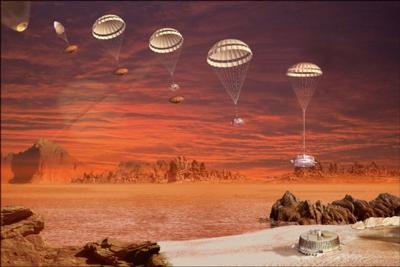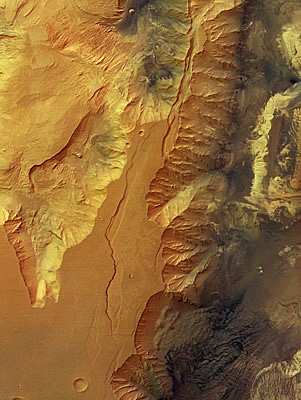New Research Of 2005 Landing Shows A Complex Planetary Surface
New analysis shows that the European Space Agency's Huygens probe, ferried to Saturn's moon Titan by NASA's Cassini spacecraft, bounced, slid and wobbled its way to rest in the 10 seconds after touching down on Titan in January 2005. The research shows that moon's surface is more complex than previously thought.

Scientists reconstructed the chain of events by analyzing data from a variety of instruments that were active during the impact, in particular changes in the acceleration. The instrument data were compared with results from computer simulations and a drop test using a model of Huygens designed to replicate the landing.
The analysis reveals that, on first contact with Titan's surface, Huygens made a dent 4.7 inches deep, before bouncing out onto a flat surface. The Huygens probe, which had a mass of about 400 pounds, hit the ground with an impact speed that was similar to dropping a ball on Earth from a height of about 3 feet . The probe, tilted by about 10 degrees in the direction of motion, then slid 12 to 16 inches across the surface. It slowed due to friction with the surface and, upon coming to its final resting place, wobbled back and forth five times. Each wobble was about half as large as the previous one. Huygens' sensors continued to detect small vibrations for another two seconds, until motion subsided nearly 10 seconds after touchdown.
"A spike in the acceleration data suggests that during the first wobble, the probe likely encountered a pebble protruding by around an inch [2 centimeters] from the surface of Titan, and may have even pushed it into the ground, suggesting that the surface had a consistency of soft, damp sand," said Stefan Schröder of the Max Planck Institute for Solar System Research in Katlenburg-Lindau, Germany, lead author of the paper reporting the results in the journal Planetary and Space Science.

Previous work measured the firmness of Titan's surface during the Huygens impact. Those results found the surface to be quite soft. The new work goes one step farther to demonstrate that if something put little pressure on the surface, the surface was hard, but if an object put more pressure on the surface, it sank in significantly. "It is like snow that has been frozen on top," said Erich Karkoschka, a co-author at the University of Arizona, Tucson. "If you walk carefully, you can walk as on a solid surface, but if you step on the snow a little too hard, you break in very deeply."
Had the probe impacted a wet, mud-like substance, its instruments would have recorded a "splat" with no further indication of bouncing or sliding. The surface must have therefore been soft enough to allow the probe to make a sizeable depression, but hard enough to support Huygens rocking back and forth. "We also see in the Huygens landing data evidence of a ‘fluffy' dust-like material – most likely organic aerosols that are known to drizzle out of the Titan atmosphere – being thrown up into the atmosphere and suspended there for around four seconds after the impact," said Schröder.
Since the dust was easily lifted, it was most likely dry, suggesting that there had not been any rain of liquid ethane or methane for some time prior to the landing. "This study takes us back to the historical moment of Huygens touching down on the most remote alien world ever visited by a landing probe," added ESA's Cassini-Huygens project scientist, Nicolas Altobelli. "Huygens data, even years after mission completion, are providing us with a new dynamical ‘feeling' for these crucial first seconds of landing."
 Classic Aero-TV: Up Close And Personal - The Aeroshell Aerobatic Team at Oshkosh
Classic Aero-TV: Up Close And Personal - The Aeroshell Aerobatic Team at Oshkosh ANN's Daily Aero-Term (07.13.25): Tactical Air Navigation (TACAN)
ANN's Daily Aero-Term (07.13.25): Tactical Air Navigation (TACAN) ANN's Daily Aero-Linx (07.13.25)
ANN's Daily Aero-Linx (07.13.25) NTSB Prelim: Pitts S2
NTSB Prelim: Pitts S2 Airborne 07.09.25: B-17 Sentimental Journey, Airport Scandal, NORAD Intercepts
Airborne 07.09.25: B-17 Sentimental Journey, Airport Scandal, NORAD Intercepts




